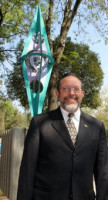Climate & Environment
AXA Projects
Mexico
Use of Historical Seismic Records as Realizations of a Diffuse Field for Tomography of Alluvial Basins: Application for the Valley of Mexico City
When an earthquake tears through the Earth, its irregular energy ripples out from the starting point in every direction. The nature and duration of the ground shaking that occurs is then determined, in part, by the characteristics of the local geology. Clearly, anticipating these effects would be an important element in successfully preparing for and minimizing the damage of future seismic events. That is what Prof. Sánchez-Sesma hopes to do for the Mexico City valley region. His team is developing new methods making use of old data—from more than 100 earthquakes recorded over the last 25 years—to get a better picture of the Earth’s near-surface interior.
One way to understand what’s inside an object, like our planet, is to observe how waves of energy behave when they pass through it. By analysing the way earthquake surface waves were deflected by geological materials as they moved through the Earth’s crust, Prof. Sánchez-Sesma can deduce the kind of material they encountered. The time they took to travel from the starting point to different recording stations tells him where and by how much geological factors caused the waves to speed up. Together, this information allows Prof. Sánchez-Sesma to create high-resolution maps of seismic surface wave velocities – a characteristic of great importance to city planning and disaster preparation. These tools, whether developed for the Mexico City basin or for other seismically at-risk locations, are useful to construct scenarios of ground motion. This information could provide decision makers with estimates of how their region will respond to an earthquake. The result stands to be better engineering, better construction and better preparedness before the next big quake strikes.
One way to understand what’s inside an object, like our planet, is to observe how waves of energy behave when they pass through it. By analysing the way earthquake surface waves were deflected by geological materials as they moved through the Earth’s crust, Prof. Sánchez-Sesma can deduce the kind of material they encountered. The time they took to travel from the starting point to different recording stations tells him where and by how much geological factors caused the waves to speed up. Together, this information allows Prof. Sánchez-Sesma to create high-resolution maps of seismic surface wave velocities – a characteristic of great importance to city planning and disaster preparation. These tools, whether developed for the Mexico City basin or for other seismically at-risk locations, are useful to construct scenarios of ground motion. This information could provide decision makers with estimates of how their region will respond to an earthquake. The result stands to be better engineering, better construction and better preparedness before the next big quake strikes.
Earthquake History to Predict the Seismic Future
To add or modify information on this page, please contact us at the following address: community.research@axa.com

Francisco José
SÁNCHEZ SESMA
Institution
Universidad Nacional Autónoma de México
Country
Mexico
Nationality
Mexican